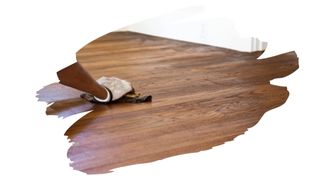Polyurethane is one of the best ways to protect your floor from scratches and water damage.
It’s easy to apply, and dries really fast (particularly water-based poly’s). And it doesn’t need much upkeep or maintenance afterward.
But, a clear polyurethane finish can tend to leave otherwise gorgeous hardwood floors, looking a bit plain. Or it can leave behind a film that makes your floor look like it’s been vacuum sealed with plastic.
And so this is where wood stain comes in. A quality oil-based wood stain can enhance the vibrancy and texture of wood.
But, if you want the best of both worlds — superb stain color and a fantastic poly finish — can you simply mix the two together?
Well, in this post, you will learn the simplest way to change the color of a polyurethane finish. You will also find out the three main reasons why a stain/poly blend rarely works out.

This post may contain affiliate links to products that we receive a commission for (at no additional cost to you). Learn more here.
Can You Change And Darken The Color Of Polyurethane?
It’s pretty easy to change up the color of a polyurethane finish. You simply need to blend it with another tinted poly finish.
As long as both poly finishes are the same make and brand, you can personalize the color of poly.
And Which Is Better? Is Water Or Oil Based Polyurethane Better For Hardwood Floors?
Well, oil based polyurethane finishes will give wood the most natural looking poly finish out of the two.
Yet, water-based polyurethanes are a time saver. They dry much faster than their oil-based counterparts. But, the trade-off is that they also leave behind a more ‘plastic’ looking film than oil-based poly’s.
Related Post: Can You Apply Polyurethane On Pine Wood?
Will A Stain And Poly Blend Work? [3 Reasons Why They Won’t]
More often than not, blending these two very different wood finishes doesn’t work out. And that’s mainly because of the binders used in wood stain finishes.
You see, wood stains are made of two key ingredients; pigments and binders.
First, wood stains sink down into timber, and add color to wood fibers. And then the pigment stays affixed onto those fibers thanks to the binder.
Now, depending on your particular stain brand, the binders used can vary wildly.
Wood stain binder ingredients can be anything from varnish to linseed oil, and even sometimes polyurethane. And this varied range of binder ingredients means that, more often than not, wood stains don’t blend well with poly.
So, the three main reasons why stain and poly don’t make for a great blended finishes are:
1: Oil And Water Don’t Mix
An oil-based wood stain won’t mix with water-based polyurethanes. The reason for this is simple…oil doesn’t blend at all well with water.
You might be able to get them to mix. But, the water-content in water-based poly’s can cause wood stain to appear more cloudy than transparent.
You often see this cloudy effect appear on stained surfaces where moisture got into the stain before it could dry. This is called ‘blushing’, and can it can cause white residue to appear after staining.
Related Post: What’s With All This White Residue After Staining? (+ How To Fix It)
And a somewhat similar effect can happen when you mix oil-based stains with water-based poly’s.
2: Poly Blocks Wood Stain
Even if you get an oil-based stain to blend with an oil-based polyurethane, you end up with another problem. And that problem lies in the application.
Wood stains need to soak into wood grain to work. While polyurethane products tend to sit on the surface of wood.
By mixing these two products together, you nix wood stain’s ability to sink down evenly into wood grain. And that can create an uneven looking stain coat.
3: Drying Times Are Mismatched
Last but not least, there’s another little problem with their mismatched drying times. Wood stains, (especially ones with varnish as a binder), have much short drying times than most polyurethane finishes.
Wood stains can dry in as little as 2 hours. Whereas an oil-based polyurethane finish will need 24-48 hours to dry enough between coats.
So, when you blend stain and poly together, the first application might go on okay. But, the following application coats are going to appear increasingly uneven as that mismatched-blend doesn’t dry evenly.
So How Do You Add Both Stain And Polyurethane To Hardwood Floors?
Well, there are no shortcuts here. You’re simply going to have to apply the stain and poly finishes separately.
Apply the stain first, (always — never the reverse), and wait for it to dry. After that, you can top coat the polyurethane over it to seal that color in.
Related Post: What To Do About White Mould Under Your Hardwood Floorboards
And How Long Should You Wait To Apply Polyurethane After Staining?
Always check the label of your wood stain product.
There are no real industry standard blends when it comes to wood stains. And each brands drying times can vary from each other.
Nevertheless, as a general rule of thumb, most hardwood floor wood stains should be dry enough to coat over within about 24 hours.
Related Post: Can You Use Mineral Spirits On Hardwood Floors?
But What Happens If You Apply Polyurethane Before That Stain Is Dry?
Polyurethane will peel off if you apply it before wood stain has had time to cure.
This is especially likely to happen if you apply polyurethane over a wet and/or curing oil-based wood stain.
Curing refers to a chemical reaction that’s separate from the drying process that wood finishes go though. This curing reaction changes their chemical structure of an oil-based finish, turning it into a solid substance.
So, a cured wood stain isn’t just dry to the touch, it is also dry ‘underneath’ the surface, and solidified.
Will Polyurethane Stick To A Dry And Cured Wood Stain?
It will, but with one caveat; you need to give polyurethane a scuffed surface to ‘cling’ onto.
Polyurethane is such a slick finish, that you need to give it a gritty surface, if you want it to adhere. And the way we do this is by lightly sanding that stained surface, before we coat polyurethane onto it.
Those little bits of sanded grit are enough to prevent polyurethane from peeling off after application. So, use a drum sander to create a gritty surface across the floor, prior to applying polyurethane.

To Wrap Up, Here Are The 3 Key Takeaways From This Post…
- 1). If you want to personalize the color of a polyurethane finish, then simply blend two different tinted poly finishes together.
- 2). But, make sure they are both from the exact same brand and make (albeit different colors).
- 3). Wood stains and polyurethane blends rarely work out well. The polyurethane, which sits mainly on the surface of wood, can prevent stain from evenly sinking into wood.
